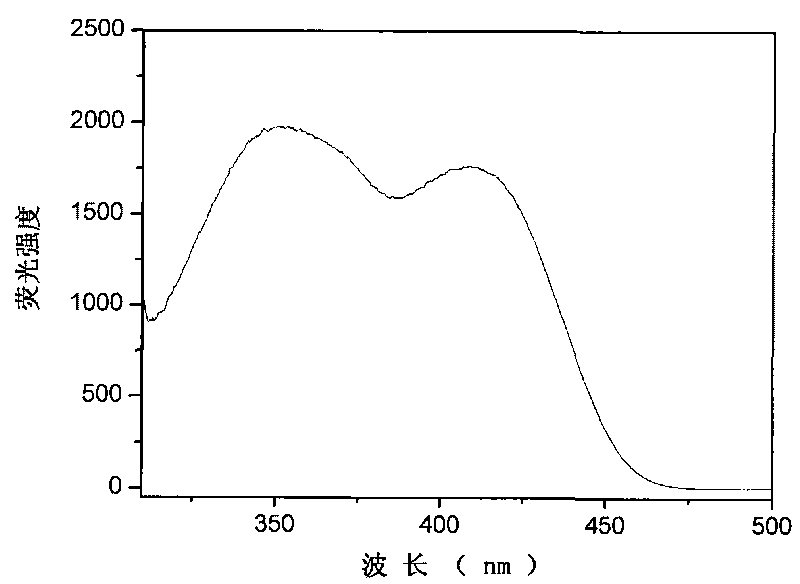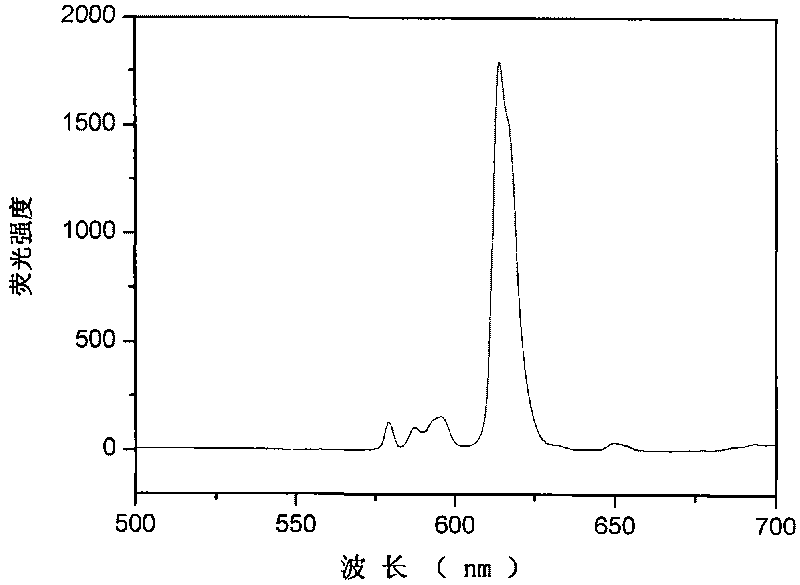Fluorescent nanoparticle and preparation method and application thereof
A fluorescent nanometer and nanoparticle technology, applied in the field of fluorescent nanoparticles and their preparation, can solve the problems of loss of excitation and luminescence characteristics, unsatisfactory nanoparticle dispersion, easy to agglomerate, etc., and achieves good long-wave visible light excitation luminescence performance, excellent dual Photon-excited luminescence performance and the effect of large Stocks displacement
- Summary
- Abstract
- Description
- Claims
- Application Information
AI Technical Summary
Problems solved by technology
Method used
Image
Examples
Embodiment 1
[0043] Embodiment 1: Based on [Eu(tta) 3 Preparation of fluorescent nanoparticles of dpbt]
[0044] Octyltrimethoxysilane (OTS), polymethylmethacrylate (PMMA) and [Eu(tta) 3 dpbt] (its structural formula is shown in formula III; Y.Wang, et al., Angew.Chem.Int.Ed.2004, 43, 5010) was dissolved in acetone, and the concentration of OTS was prepared to be 7.6×10 -4 mol / L, PMMA concentration is 1.6×10 -5 mol / L,[Eu(tta) 3 dpbt] at a concentration of 1.6 × 10 -4 mol / L acetone solution, denoted as solution A1. At room temperature and under stirring conditions, add 25mL of solution A1 dropwise to 75mL with a concentration of 1.0×10 -3 mol / L cetyltrimethoxyammonium bromide (CTAB) aqueous solution (referred to as solution B1) (solution A1 and solution B1 volume ratio is 1: 3), stirred for 10min, obtained PMMA, organosiloxane A complex of alkanes and organosilicon polymers (reticular polymers formed by hydrolysis of OTS and condensation of silanol groups) as a matrix, coated with [Eu...
Embodiment 2
[0050] Embodiment 2: Based on [Eu(tta) 3 Preparation of fluorescent nanoparticles of dpbt]
[0051] According to the method in embodiment 1, replace PMMA to prepare A2 with methyl methacrylate styrene copolymer (P(St-co-MMA)), each solute concentration in this solution is: OTS, 7.6×10 -4 mol / L; P(St-co-MMA), 1.6×10 -4 mol / L; [Eu(tta) 3 dpbt], 1.6×10 -4 mol / L; at room temperature and under stirring conditions, add 30mL of solution A2 dropwise to 70mL with a concentration of 1.4×10 -3 The aqueous solution of mol / L CTAB (referred to as solution B2) was stirred for 10 min to obtain a network polymer composed of P(St-co-MMA), organosiloxane and organosilicon polymer (OTS hydrolyzed and formed by silanol condensation) The complex of the substance) is a matrix, including [Eu(tta) 3 dpbt] fluorescent nanoparticles sol (referred to as sol C2).
[0052] The TEM test results show that the size distribution range of the fluorescent nanoparticles in the sol C1 prepared above is 22-85...
Embodiment 3
[0054] Embodiment 3: take the composite of PMMA, organosiloxane and organosilicon polymer as matrix based on [Eu(tta) 3 Preparation of fluorescent nanoparticles of dpbt]
[0055] According to the method in Example 2, replace P(St-co-MMA) with PMMA, replace acetone with acetonitrile to prepare A3; replace CTAB with bovine serum albumin to prepare solution B3, the concentration of bovine serum albumin is 3.0mg / mL. According to the preparation method and conditions in Example 2, the composite of PMMA, OTS and organosilicon polymer (OTS hydrolyzed and formed by silanol condensation) was prepared as matrix material, based on [Eu(tta) 3 dpbt] fluorescent nanoparticles sol, denoted as sol C3.
[0056] The TEM test results show that the size distribution of the fluorescent nanoparticles in the sol C3 prepared above is 10-40 nm, and the average particle diameter is 25 nm. The prepared fluorescent nanoparticles were centrifuged, washed with water, dried, and the OTS in the medium was ...
PUM
| Property | Measurement | Unit |
|---|---|---|
| The average particle size | aaaaa | aaaaa |
| Size distribution | aaaaa | aaaaa |
| Size | aaaaa | aaaaa |
Abstract
Description
Claims
Application Information
 Login to View More
Login to View More - R&D
- Intellectual Property
- Life Sciences
- Materials
- Tech Scout
- Unparalleled Data Quality
- Higher Quality Content
- 60% Fewer Hallucinations
Browse by: Latest US Patents, China's latest patents, Technical Efficacy Thesaurus, Application Domain, Technology Topic, Popular Technical Reports.
© 2025 PatSnap. All rights reserved.Legal|Privacy policy|Modern Slavery Act Transparency Statement|Sitemap|About US| Contact US: help@patsnap.com



